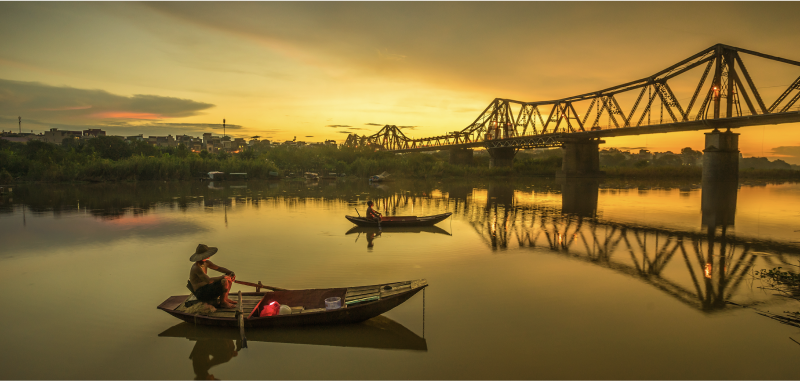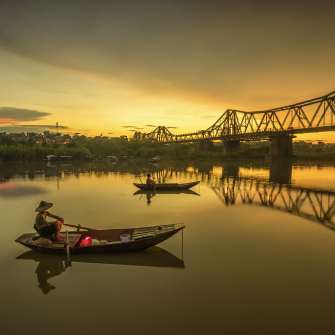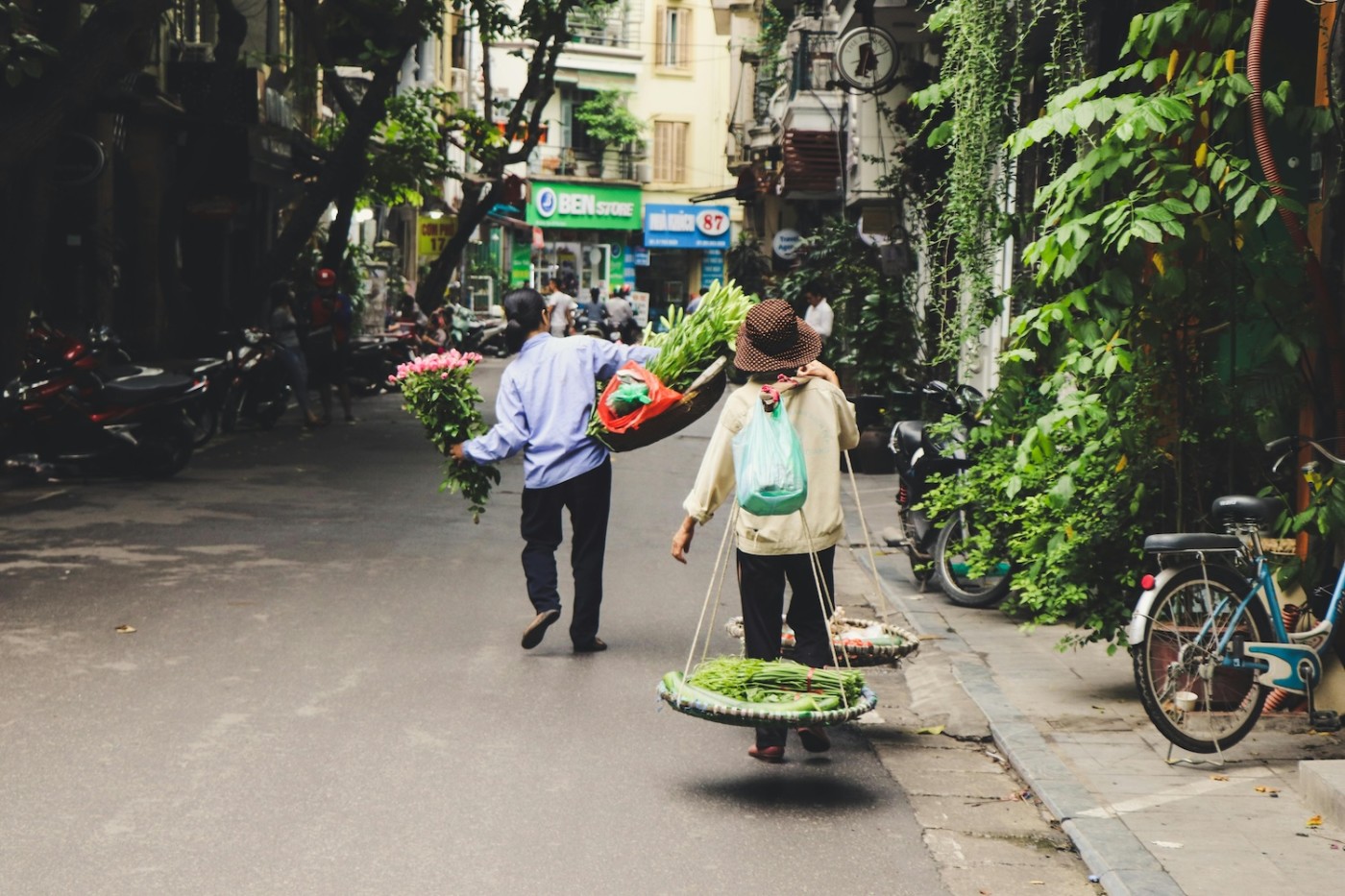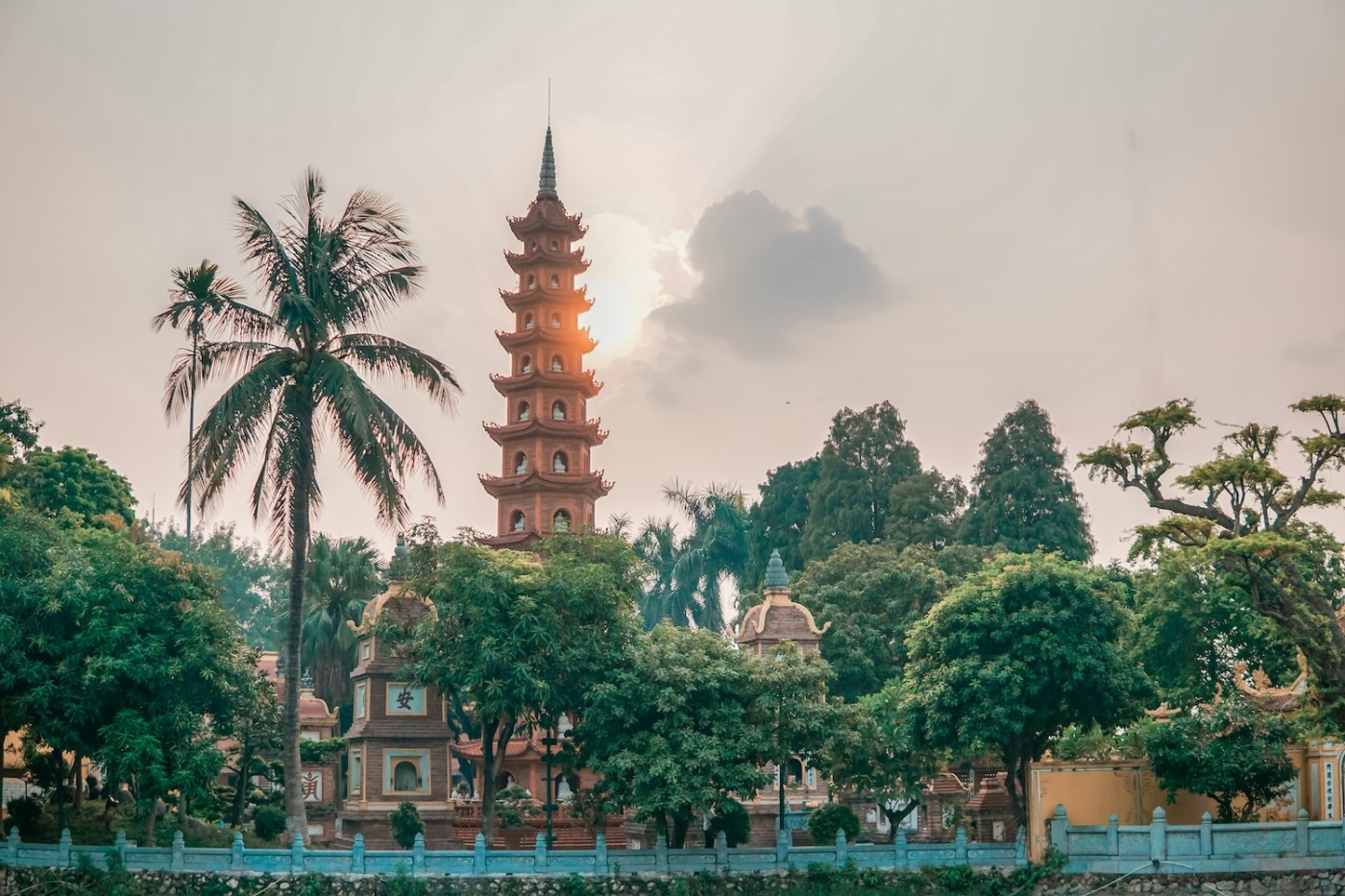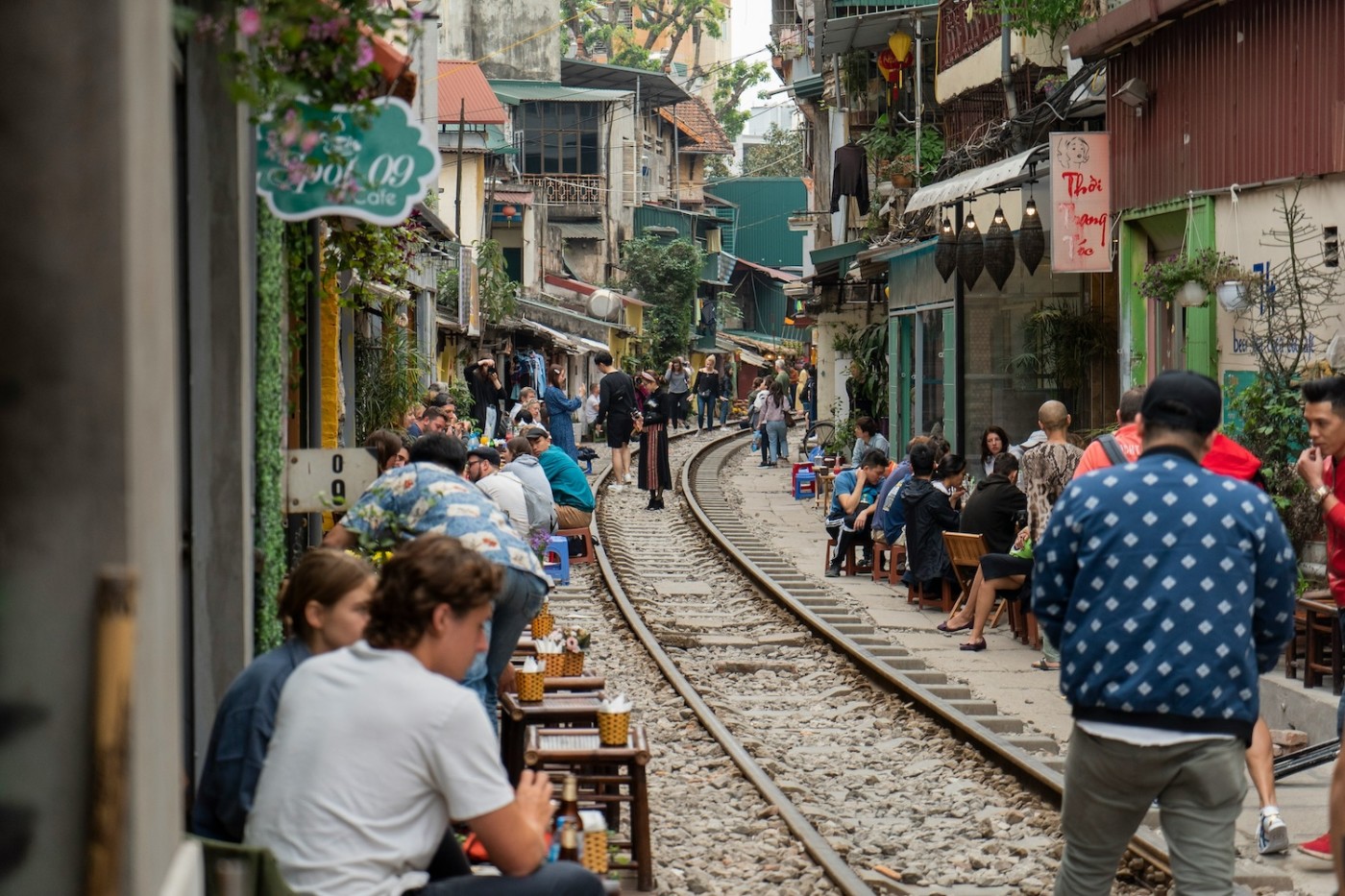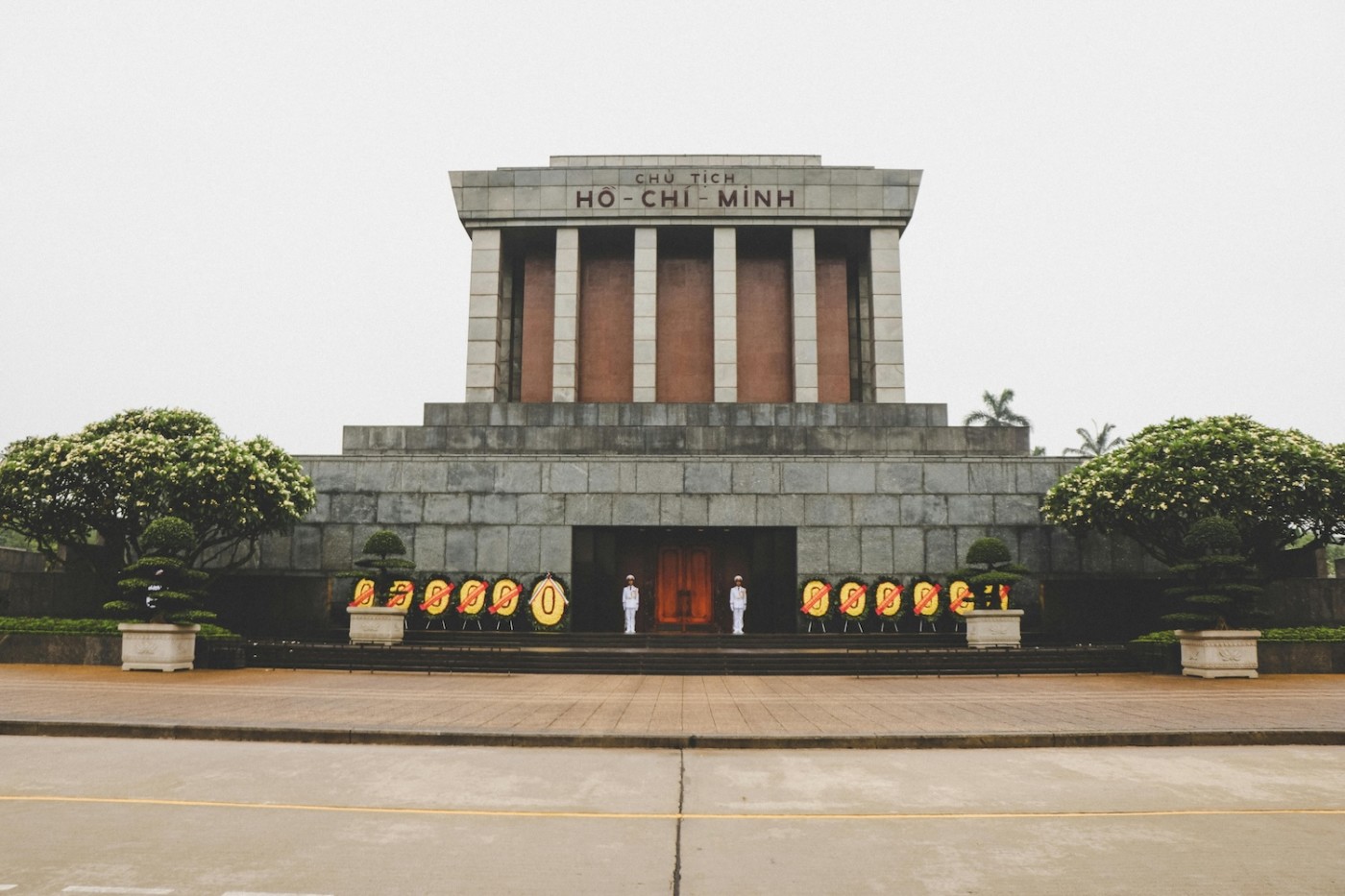Located in the heart of Northern Vietnam is capital city, Hanoi—a pulsating hub of local culture with a rich history that spans over a thousand years. As you stroll through its bustling streets, you'll encounter a city where traditional Vietnamese architecture sits alongside contemporary buildings, creating a dynamic urban landscape.
The city's deep cultural heritage is palpable at every turn, from its well-preserved colonial buildings to the maze-like alleyways of its Old Quarter, where the air is filled with the enticing aromas of local cuisine and the sounds of everyday life. The city is like a living exhibit, showcasing a history marked by influences from Chinese and French rule, evident in its architecture, cuisine, and cultural norms.
For explorers, Hanoi is also a gateway to the vast Northern Vietnam region, offering convenient access to breathtaking landscapes like the terraced fields of Sapa and the awe-inspiring Ha Long Bay. The city is a perfect launchpad for those eager to uncover the natural beauty and traditions that have shaped the lives of its people over the ages.
Whether the historical sites, the lively atmosphere of its streets, or the warmth of its people, Hanoi promises an engaging experience that offers an in-depth look into the soul of Vietnam.
Exploring Hanoi: Top Attractions and Hidden Gems
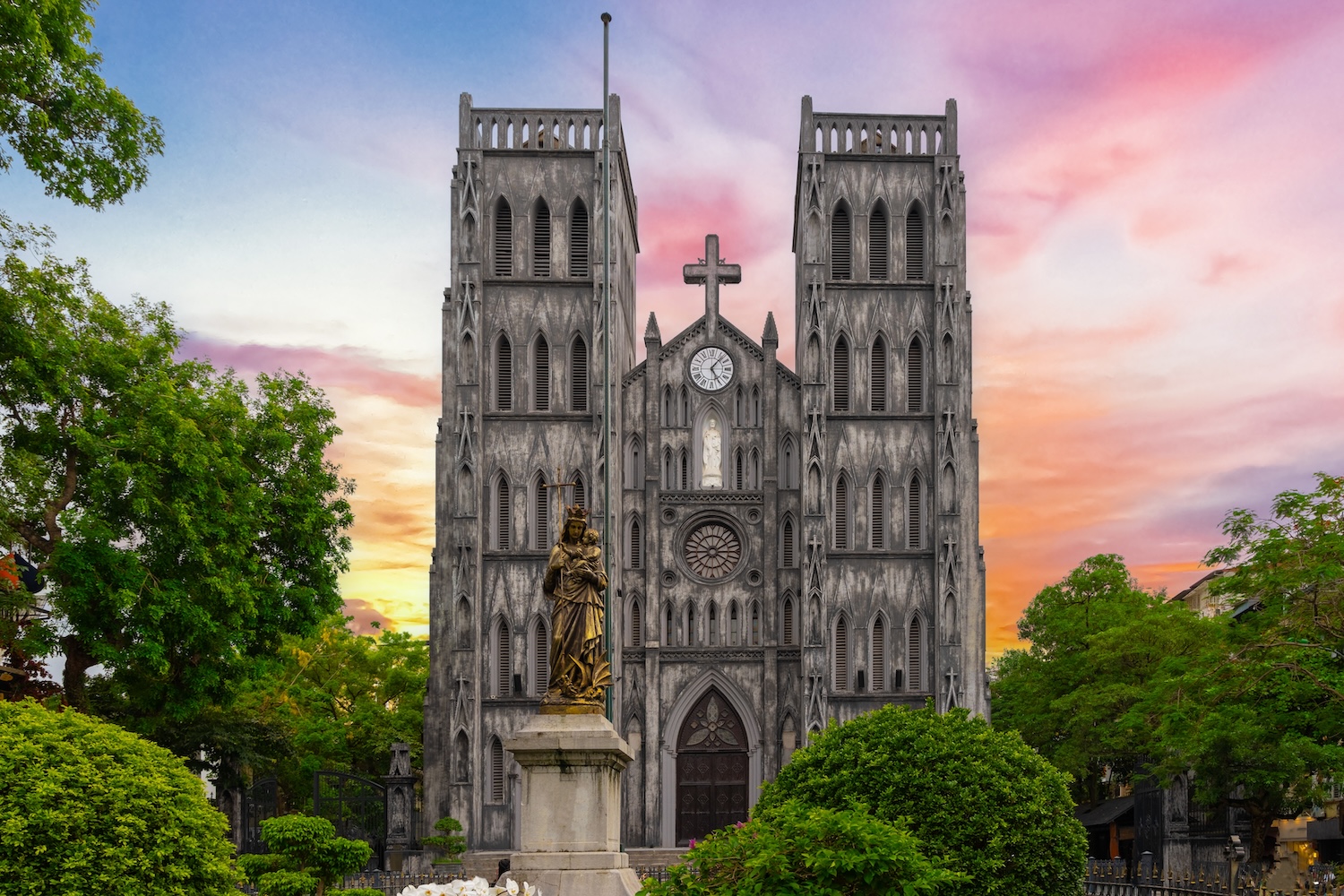
Hanoi is filled with historic landmarks that tell its storied past. The Temple of Literature, founded in 1070, is a celebrated example of traditional Vietnamese architecture. It was here that Vietnam's first university began, offering visitors a unique glimpse into the scholarly life of ancient times with its detailed carvings and serene courtyards providing a peaceful break from the buzz of the city.
A short distance away, the Ho Chi Minh Mausoleum stands as an iconic monument to the revolutionary leader. The granite structure is located in Ba Dinh Square, where Ho Chi Minh read the Declaration of Independence in 1945, establishing the Democratic Republic of Vietnam. The mausoleum is a place of deep national significance and a pilgrimage site for many, where the preserved body of 'Uncle Ho' is displayed.
Stroll Through the Old Quarter
The Old Quarter is the pulsating heart of Hanoi, known for its colonial architecture, hidden alleyways and cosy coffee shops filled with locals. Each street was traditionally dedicated to a specific trade, a fact still reflected in the street names. From ancient temples to colourful shops selling silk, spices, and souvenirs, the Old Quarter has something for everyone.
For a truly immersive experience, hop on a cyclo ride. This traditional, pedal-powered vehicle offers a leisurely way to navigate the crowded lanes, allowing you to take in the sights and sounds with ease. As evening sets in, head to Bia Hoi Junction and Ta Hien Street, affectionately known as 'Beer Street.' Here, travellers and locals sit on small plastic seats, drinking draft beer while watching the city's vibrant nightlife unfold.
Cultural Shows and Events
Hanoi's culture is best experienced through its various shows and festivals. The Thang Long Water Puppet Theatre offers a unique spectacle that blends folk music with a form of puppetry that dates back centuries. Set in a pool of water, the puppets appear to be moving over the water's surface, depicting scenes from rural life or historical legends. It's a performance that captivates children and adults alike, providing insight into the artistic traditions of Vietnam.
The Mid-Autumn Festival, or Tet Trung Thu, is another cultural highlight, with colourful streets filled with decorations, lanterns, and masks. Hang Ma Street transforms into a vibrant marketplace of toys and treats, culminating in lively displays around Hoan Kiem Lake. Puppet shows, lion dances, and the ubiquitous mooncakes offer a feast for the senses and a unique opportunity for visitors to join in a cherished local tradition.
Culinary Delights: A Taste of Hanoi
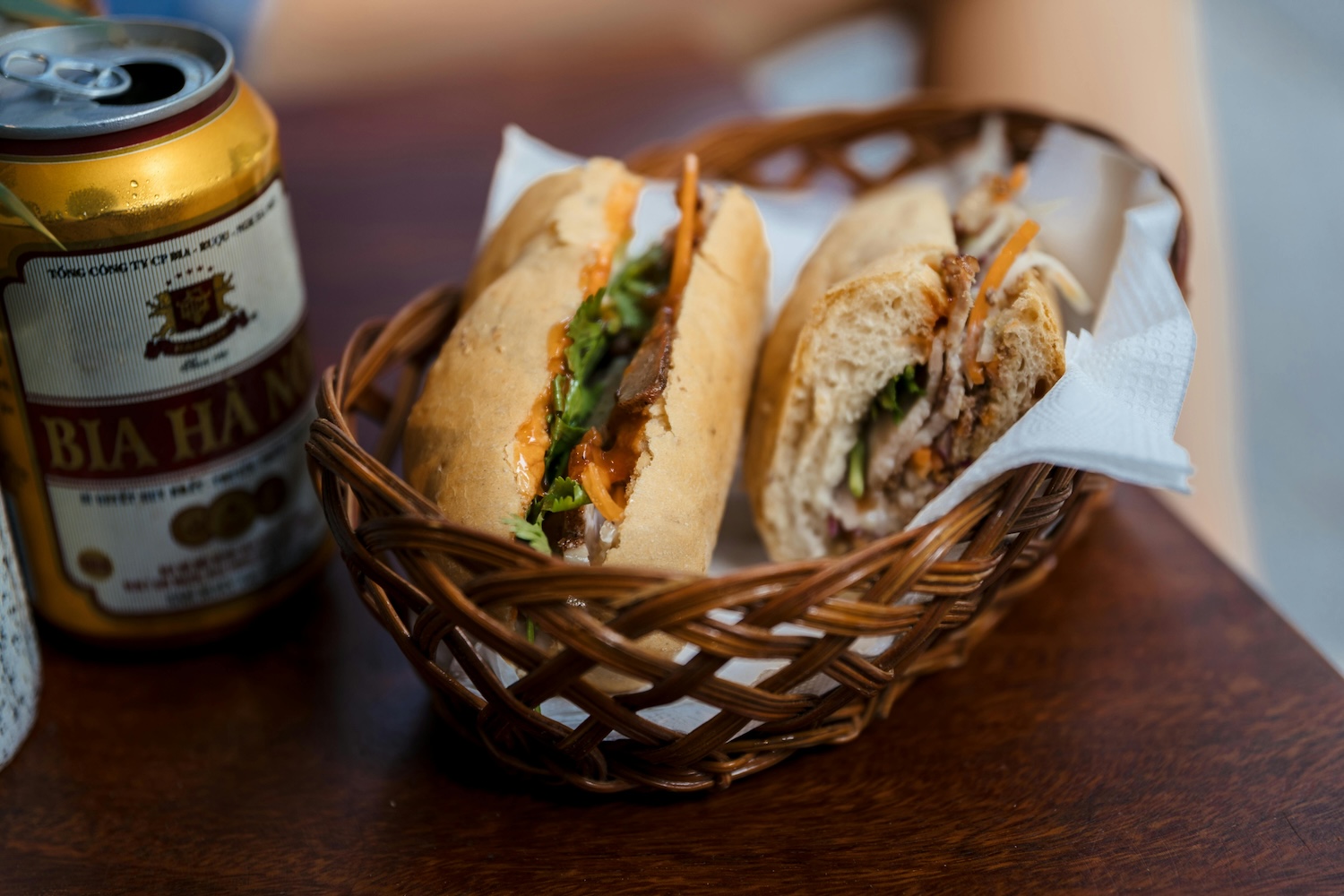
Hanoi is a foodie paradise, offering a diverse palette of flavours that reflect the city's culinary history. The streets of Hanoi are lined with vendors and small eateries where you can savour a few Vietnamese favourites.
Pho, arguably Vietnam's most famous dish, is a must-try in Hanoi. This aromatic noodle soup, typically served with either beef or chicken and infused with herbs like coriander and green onions, is the ultimate comfort food. For the best experience, visit Bat Dan Street in the Old Quarter early in the morning to enjoy Pho from one of the many stalls.
Another local favourite is Bun Cha made with grilled pork patties, served over a plate of white rice noodles, herbs, and a side of dipping sauce. Head to the Hoan Kiem District at lunchtime to enjoy some of the best Bun Cha in town.
Seafood fans, be sure to sample Cha Ca, a grilled fish dish seasoned with dill and turmeric, typically eaten with rice noodles. Cha Ca Thang Long on Duong Thanh Street is highly recommended for a truly authentic experience.
Coffee Culture in Hanoi
Hanoi's coffee culture is as popular as its culinary scene, with a tradition that dates back over a century. The city has traditional coffee shops and modern cafes offering a unique take on Vietnamese coffee. One of Hanoi's beloved coffee creations is the Ca Phe Trung, or egg coffee. This Hanoi invention combines creamy whipped egg yolks with coffee and sugar, creating a rich and frothy topping similar to a tiramisu.
Giảng Café is famed as the birthplace of egg coffee and is a cosy spot hidden down a narrow lane in the Old Quarter. For a more contemporary setting, The Note Coffee offers a vibrant atmosphere with notes from customers worldwide adorning its walls, making it a popular spot among tourists.
Local Markets
Hanoi's lively food markets are a showcase of culture and cuisine, offering a sensory feast for visitors and locals alike. From the bustling stalls of the historic Dong Xuan Market to the smaller shopping hubs scattered throughout the city, these markets are where traditional Vietnamese culinary practices come to life. Early mornings in these markets are particularly magical as Hanoi awakens and vendors lay out their freshest produce, ready for the day's haggling and cooking to begin.
Day Trips and Excursions from Hanoi

If you're eager to explore beyond the city, venture to Hanoi's surrounding regions filled with breathtaking landscapes and cultural sites, from the iconic limestone islands of Ha Long Bay to the scenic terrains of Ninh Binh and the lush rice terraces of Sapa.
Ha Long Bay
A trip to Northern Vietnam would be incomplete without visiting Ha Long Bay, a UNESCO World Heritage Site known for its spectacular seascape of limestone pillars and tiny islets topped with forest. Located about 170 kilometres east of Hanoi, this natural wonder is best explored by junk boat. Several operators offer day trips and overnight stays on boats ranging from standard to luxury. These cruises typically include kayaking, visiting caves, and sometimes even participating in onboard cooking classes.
When booking a cruise, you should check the options available through reputable platforms or directly with established cruise companies. Most tours include transfers from Hanoi, meals, and guided activities. Early booking is recommended to secure a spot, especially during the peak travel seasons from November to April.
Ninh Binh Province
Just a two-hour drive from Hanoi, Ninh Binh is often referred to as "Ha Long Bay on Land" due to its stunning limestone karst landscapes and meandering rivers. Tours to this area usually include visits to Hoa Lu, the ancient capital of Vietnam, and a boat ride in Tam Coc, where you can glide along the river that flows through a landscape of rice fields and caves.
The area is rich in history and natural beauty, with options to explore by bicycle, boat, or even on foot. Many tours also include the Bich Dong Pagoda, a series of cave temples built among beautiful karst mountains. For those interested in photography or nature, Ninh Binh provides a serene backdrop that contrasts sharply with Hanoi's urban bustle.
Sapa Adventure
For the more adventurous, Sapa offers an incredible journey through the rugged scenery of Vietnam's northern highlands. Located in the Lao Cai Province, about 320 kilometres northwest of Hanoi, Sapa is renowned for its terraced rice fields, misty landscapes, and local hill tribes, including the Hmong, Dao, and Tay.
Travelling to Sapa usually involves an exciting overnight train journey from Hanoi to Lao Cai, followed by a short bus ride. Once in Sapa, there are numerous trekking options that take you through lush valleys and charming villages, often with the chance to stay overnight in local homestays.
Tour operators in Hanoi offer various packages for Sapa, ranging from low-key adventures to more strenuous treks. Custom tours are also available for those seeking a more tailored experience, focusing on cultural immersion, photography, or extensive trekking.
Must-See Views and Instagram-Worthy Spots in Hanoi
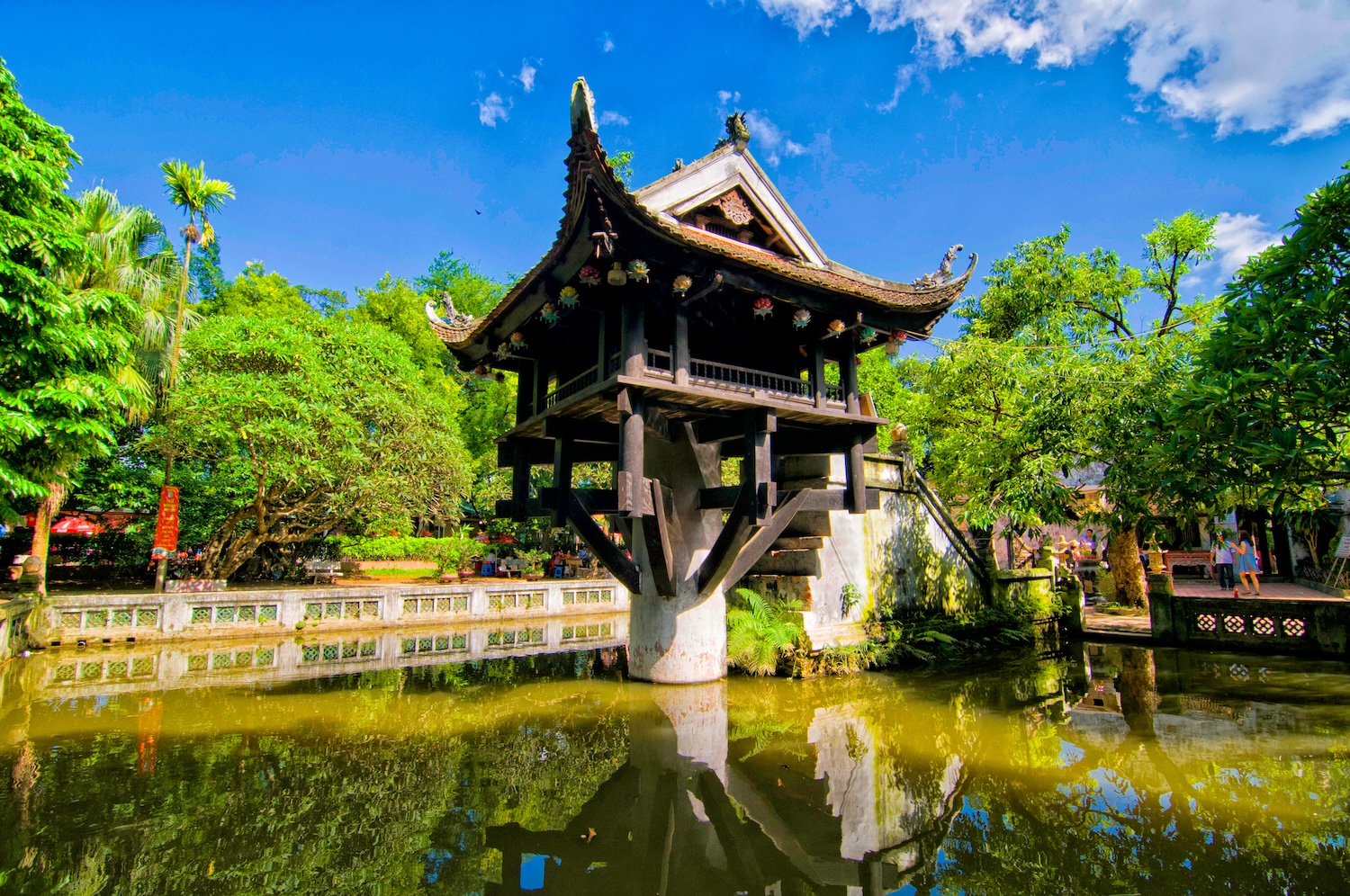
Hanoi is a treasure trove of cultural and historical riches, with an abundance of stunning visual scenes perfect for capturing on camera. From the tranquil shores of Hoan Kiem Lake to landmarks bathed in golden light and the colourful chaos of the Old Quarter's markets, each location reveals a new perspective.
Hoan Kiem Lake and The Huc Bridge
At the heart of Hanoi lies Hoan Kiem Lake, a tranquil oasis amidst the busy city. The lake is known for its clear, peaceful waters and the picturesque Huc Bridge, a delicate red structure that connects the shore to Jade Island and the Temple of the Jade Mountain. Capture the lake in the early morning, as the sun rises and the city wakes, or at sunset, when the sky and the lake take on hues of pink and orange. The bridge, lit up at night with the reflection shimmering in the water, provides a spectacular view and is a must-capture for any visitor.
Long Bien Bridge
For a slice of history, head to Long Bien Bridge, a symbol of Hanoi's colonial past and a survivor of numerous bombings during the Vietnam War. This cantilever bridge provides a unique vantage point over the city and the Red River below. Visiting at sunrise allows you to capture the breathtaking scene as the early light casts a soft glow over the city and river, creating the perfect backdrop for a stunning snap.
Train Street
Nestled between residential buildings, the famous Train Street is where trains pass just mere feet away from the doorsteps of homes and cafes. This unique spot offers an exciting and slightly nerve-racking photo opportunity. The juxtaposition of everyday life and the thundering train makes for dynamic shots that capture the essence of Hanoi's urban life. Note: It's essential to follow local regulations and ensure safety while capturing photos here.
Lotte Tower Observation Deck
For those looking to capture a panoramic view of the city, the Lotte Tower Observation Deck offers an unobstructed 360-degree view of Hanoi. From here, photographers can capture the sprawling city during the day or the dazzling lights at night. It's an ideal spot for those looking to get high-up cityscapes that showcase the vastness and vibrancy of Hanoi.
Old Quarter Rooftop Cafes
For a different vantage point, visit one of the many rooftop cafes in Hanoi's Old Quarter. These spots offer views over the dense and intriguing tile roofs and maze-like streets, capturing the frenetic energy of Hanoi.
When to Visit: Best Times to Explore Hanoi
Choosing the right time to visit Hanoi can enhance your experience, as the city's charm unfolds in unique ways across different seasons. Hanoi experiences a typical Northern Vietnam climate, characterised by a distinct wet and dry season, each bringing its own set of attractions and activities suitable for visitors.
The Dry Season (November to April)
The dry season, stretching from November to April is generally considered the best time to visit Hanoi. The weather is relatively cool and dry during these months, with average temperatures ranging from 17°C to 22°C. This period is ideal for exploring the city's outdoor attractions without the discomfort of heavy rainfall or the extreme heat that can occur in summer.
Early in the dry season, particularly in November and December, the weather is cool and pleasant, making it perfect for walking tours around the Old Quarter or enjoying a leisurely bike ride around West Lake. The cooler temperatures also make this time ideal for excursions to nearby regions like Ha Long Bay or Ninh Binh, where you can enjoy the natural landscapes in comfortable weather.
As the season progresses towards February and March, Hanoi celebrates the Lunar New Year (Tet), Vietnam's most important festival. Visiting during Tet can be a double-edged sword. While it offers a unique cultural experience with vibrant festivities and special foods, many shops and restaurants may be closed, and prices for accommodation and travel services can spike.
The Wet Season (May to October)
The wet season runs from May to October and is marked by higher temperatures and increased humidity, with frequent heavy rainfall. Temperatures during this time can climb to around 30°C. While this may deter some visitors, the rainy season also brings a unique beauty to Hanoi, with lush greenery and vibrant street life, providing a different perspective on the city.
The rains are typically short and intense, often occurring in the afternoon, so mornings can still be a good time for sightseeing. Additionally, the wet season coincides with fewer tourists, which means less crowded attractions and often lower prices for hotels and tours. This can be an advantage for those looking to explore the city at a more relaxed pace.
Visiting during the wet season also allows you to experience Hanoi's café culture, as the rainy afternoons are perfect for enjoying a cup of Vietnamese coffee at one of the city's many quaint cafes. The lush landscapes of the countryside are also particularly striking during this time, ideal for photographers and nature lovers.
Practical Tips for Travelers

Visiting Hanoi can be an enriching and unforgettable experience, especially with careful planning and preparation. Here's a guide to help you with transportation, accommodation, and safety, ensuring a smooth and enjoyable trip to Vietnam's capital.
Getting Around Hanoi
Buses: Hanoi boasts an extensive and efficient bus network, with numerous lines covering most tourist attractions and areas of interest. Buses are cost-effective and relatively easy to use, with digital boards displaying routes in both Vietnamese and English. For real-time bus information, the 'BusMap' app is highly recommended.
Taxis: Taxis are plentiful and offer a convenient way to travel around the city. To avoid being overcharged, use reputable taxi companies such as Mai Linh or Vinasun. Most taxi drivers do not speak fluent English, so having your destination written in Vietnamese or using a map app can be helpful.
Cyclos: For a more traditional form of transportation, consider taking a cyclo ride, especially around the Old Quarter and scenic areas like Hoan Kiem Lake. Cyclos are pedal-powered rickshaws where riders sit in front and the driver pedals from behind. They offer a leisurely and picturesque way to see the city, though it's wise to agree on a price before starting your journey to avoid any misunderstandings.
Motorbike Taxis: Known locally as "xe ôm," these are a quick and flexible option for getting around. They are especially useful in traffic jams, which are common in Hanoi. Always wear a helmet and negotiate the fare before you ride.
Accommodation Tips
Choosing Your Stay: Hanoi offers a range of accommodation options, from luxury hotels to budget hostels. The Old Quarter is a popular area for tourists due to its proximity to major attractions and vibrant street life. For a quieter stay, consider the West Lake area, which is more residential and offers upscale hotels with views of the largest lake in Hanoi.
Booking: It's advisable to book accommodation in advance, especially during peak tourist seasons (November to April). Checking online reviews on platforms like TripAdvisor or Booking.com can provide valuable insights into the quality of hotel facilities and services.
Safety Tips
Street Smarts: While Hanoi is relatively safe for tourists, petty theft and pickpocketing can occur, especially in crowded places like markets or bus stations. Always keep your valuables secure and be aware of your surroundings.
Traffic Safety: Traffic in Hanoi can be overwhelming with the ubiquitous motorbikes and cars, so be extra cautious when crossing busy streets.
Health: Stick to bottled water and ensure food is freshly cooked to avoid foodborne illnesses. Most street food vendors that are popular with locals are a safe bet for trying authentic Vietnamese cuisine.
Your Gateway to Authentic Vietnam
As your exploration of Hanoi ends, you'll find that each moment spent in this dynamic city adds a layer to your understanding of its culture, history, and people. From the serene mornings by Hoan Kiem Lake to the lively nights in the Old Quarter, Hanoi offers a compelling blend of tranquillity and vibrancy that captures the essence of Vietnam. So take the memories, leave only footprints and carry the spirit of Hanoi with you wherever you go next.




 English
English
 日本語
日本語
